Religious People Are Happier Than Non-Religious People
It's time to say the 'one true thing'
So, here’s something I’ve felt compelled to say when I’m giving a public presentation in the last couple of months — “Just say the one true thing.” It’s my tendency to couch things, to provide all kinds of caveats, or downplay a finding so that I’ve got a bit of wiggle room. And in a lot of areas of social science, that’s still pretty sound advice. If you look at the relationship between one variable and another, there are often 100 articles that test out the link between the two. A majority may say it’s a positive relationship, but about 30% find no relationship or a negative one. So, a bit of hedging is necessary there.
Today, however, I’m just going to say the one true thing that shows up over and over again in the literature: religious people self-identify as happier than non-religious people. There’s just no mistaking that conclusion. There are ways to try and explain it away, certainly. For instance, maybe the causal arrow goes the opposite way — happier people tend to be more religious. But the upshot is still the same: religious nones are less happy than folks who identify with a faith tradition.
A Year Into the Pandemic, What Impact was Religion Having on Mental Distress?
This post has been unlocked through a generous grant from the Lilly Endowment for the Association of Religion Data Archives (ARDA). The graphs you see here use data that is publicly available for download and analysis through link(s) provided in the text below.
The 2023–2024 Pew Religious Landscape Survey asked respondents a very straightforward question: “Generally, how happy are you with your life these days? Are you... very happy, pretty happy, or not too happy?” In the entire sample (of nearly 37,000 respondents), 28% said they were very happy, 58% were pretty happy, and only 13% were not too happy.
But let me show you how those answers shift when you break it down by level of in-person religious attendance.
Yeah — that’s about as clear as an empirical result gets when you’re doing this type of analysis. For those who report never attending religious services in person, 19% indicate that they are “not too happy” compared to 22% who are “very happy.” But for nearly every step up in religious attendance, there’s a noticeable increase in overall happiness.
For those who attend a house of worship on a yearly basis, they are six percentage points more likely to be very happy compared to never-attenders. Monthly attenders are three points happier than yearly attenders. Weekly attenders are four points happier than monthly attenders. But then look at that huge gap between those who attend in-person worship once a week versus multiple times per week. The most religiously active are easily the happiest.
However, here’s a sobering reality — only 8% of folks in the Pew data are in that weekly+ attendance category. Meanwhile, half of the sample attends seldom or never. But those people who are the most devout are nearly twice as happy.
Now let me show you the same analysis, but this time the question asks, “How often do you watch or participate in religious services online or on TV?”
In some ways, this graph does bear a resemblance to the one about in-person religious attendance. The folks who watch services online are happier than those who don’t consume any online religious programming. For the “never” watchers, 25% are very happy. Among those who consume online worship multiple times per week, the share who are very happy is thirteen points higher. But before we all jump to the conclusion that online gathering can replace face-to-face corporate worship, take a look at the left side of the graph.
Among people who never watch a church service online, 16% indicate that they are not too happy. That number slowly moves downward as you move into yearly or monthly online attendance. However, among folks who watch online religious services at least once a week, the share who are not too happy is not substantively different from those who don’t watch at all (14% vs. 16%).
Going to a house of worship in person on a regular basis has a demonstrably large impact on personal happiness. Attending online does seem to increase happiness as well, but the effect is much more muted.
What happens when I throw both those variables into a heatmap?
The one thing that clearly jumps off the page in this graph is the top-left and top-right corners. Among people who never attend religious services online but go to a house of worship multiple times per week, nearly half of them indicate that they are very happy. For people who go in person often and also consume a lot of worship online, 46% are very happy. Recall that in the entire sample, about 28% of all respondents chose the “very happy” option.
But check this comparison out. Scan your eye across the top row of results. These are folks who attend in person multiple times per week. You can see that online worship only matters at the top end and the bottom end of the scale. People who are heading to church two or three times a week express a high level of happiness.
Now scan your eyes across the bottom row — these are people who never go to a church, synagogue, or mosque. There are two things to notice. The first is that the share of folks who never attend a house of worship and who are very happy is about half the rate of the high in-person attenders (20% vs. 40%). The other thing to note is that a person who never goes to church but watches a bunch online is not happier than one who never attends online or in person. The truly online church member is not happier than someone who is completely non-religious.
That should lead to a whole lot of reflection for churches that are investing lots of time and resources into better streaming equipment.
I wanted to show one more dimension of this, though. It’s the answer to the happiness question broken down by in-person religious attendance and decade of birth. I wanted to see if younger folks receive more benefits from going to church than older Americans.
The one finding that continues to replicate over and over here is that those who attend a house of worship weekly indicate that they are happier than those who don’t go at all. That’s true for people born in the 1950s, and it’s true for people born in the 1990s. I think the easiest way to interpret this graph is to look at the share of each birth cohort who report being very happy among never-attenders and weekly attenders.
1940s: +9
1950s: +13
1960s: +16
1970s: +13
1980s: +20
1990s: +20
2000s: +9
That’s a really interesting trend, if you ask me. For older Americans, the “happiness bump” that is derived from regular religious attendance is about 13 percentage points. Certainly nothing to sneeze at. But look at those folks born between 1980 and 1999. For people born during this time period, regular church attenders are twice as likely to be “very happy” compared to never-attenders. Going to church regularly is just huge for Millennials and older members of Gen Z.
But for those born in the 2000s, the impact is much more muted at just nine points. I don’t really know what to make of that result. Maybe it’s due to the fact that many in that cohort still have strong social ties from college? Happy to hear some guesses in the comments.
Of course, religious attendance is just one part of the equation. There’s also the concept of religious belonging. That’s the question: “What’s your present religion, if any?” And then you get a whole list of choices.
What do I notice here? Well, the overall level of happiness among different Christian groups doesn’t really vary that much. Among Black Protestants, 33% indicate that they are very happy, compared to 32% of Catholics, 31% of evangelicals, and 28% of mainline Protestants. I mean, maybe the mainline score slightly lower on this happiness metric, but it’s very marginal.
I do think we can say that the “Other Religions” category — which includes all non-Protestant or Catholic groups — is slightly more likely to be “not too happy” at 18%. That’s about five points higher than the Christians in the sample. But look at the non-religious — they are clearly the group that reports the lowest level of happiness. The share who are “very happy” is nearly ten points lower than Catholics and evangelicals.
The finding from the analysis of attendance repeats here — religious people (either defined by religious behavior or religious belonging) are simply more likely to express a higher level of happiness compared to non-religious folks.
Look at the religious belonging question by birth cohort, though.
For the very oldest Americans in the sample (those born in the 1940s), there’s no difference in the level of happiness among Christians compared to the non-religious. But that’s the only birth cohort where that’s true. For people born in the 1950s, 33% of Christians report being very happy compared to only 27% of the non-religious. The happiness gap is six percentage points. Here’s what that looks like for each successive birth decade:
1960s: +5
1970s: +7
1980s: +8
1990s: +14
2000s: +8
These differences are statistically and substantively significant. I mean, look at that birth cohort born in the 1990s! Among Christians born in that decade, 34% say they are very happy. It’s just 20% of the nones born in the 1990s. Even among the youngest adults, Christians are 8 points happier than atheists, agnostics, or those who claim no religion in particular. Religion may matter even more for young adults compared to older ones.
The God Gap in American Politics
If there’s one catch phrase in my little corner of the social science world it’s, “The God Gap.” It’s the simple idea that the Republicans have become the party of religious folks, while the Democrats are much less religiously inclined.
But, of course, there are lots of countervailing forces here. Politically conservative people are more likely to be religious than political liberals. To test whether it’s ideology doing the work here, here’s what I did: I compared a liberal born in 1980–1999 to a conservative born during the same time period. One category was non-religious folks who never attended church in person; the other was Christians who attended church at least once a week.
One thing I do need to mention is that the sample size of the secular category here was about ten times larger than that of the devout category (2,009 respondents compared to only 194). But the difference in happiness is so large that the result maintains statistical significance.
Among liberals born in the 1980s or 1990s who are non-religious and never attend a house of worship, 20% of them say that they are very happy.
For liberals born in the 1980s or 1990s who indicate that they are weekly church-attending Christians, 49% said that they were very happy.
For those wondering: if I just compare conservatives in this same way, 45% of religious folks are very happy compared to 27% of the non-religious. When I compare moderates, it’s 33% vs. 17%.
Let me summarize this in a few bullet points:
People who attend a house of worship in person are significantly happier than those who never attend. There’s a positive effect for online worship, but it’s more muted.
People who identify as Christians are significantly more likely to be very happy compared to those who are non-religious.
The impact of religiosity on happiness is especially large among folks born in the 1980s and 1990s.
Even when I control for age and political ideology, religious people are much more likely to report that they are very happy compared to non-religious individuals.
To go back to where I started — let me just say the one true thing again. Highly active religious people are happier than non-religious people. There’s no other way to spin this data than this simple conclusion.
Code for this post can be found here.
Ryan P. Burge is a professor of practice at the Danforth Center on Religion and Politics at Washington University.




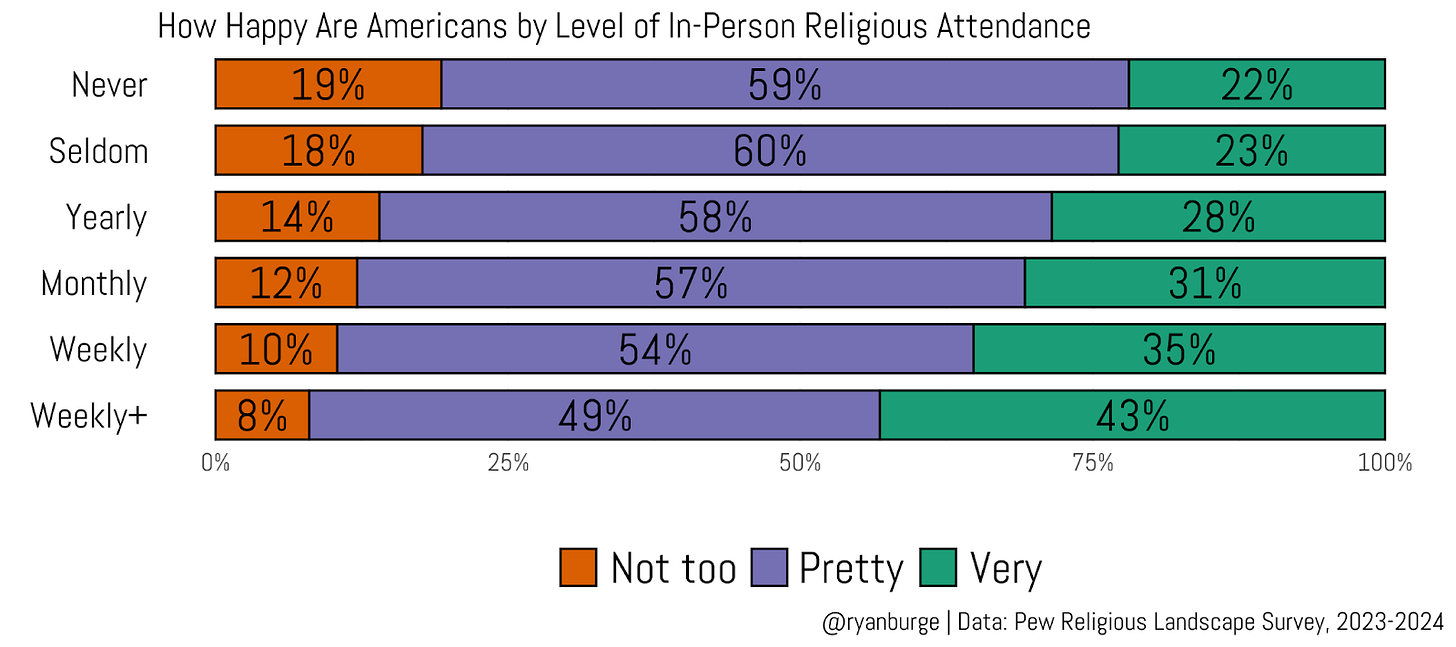
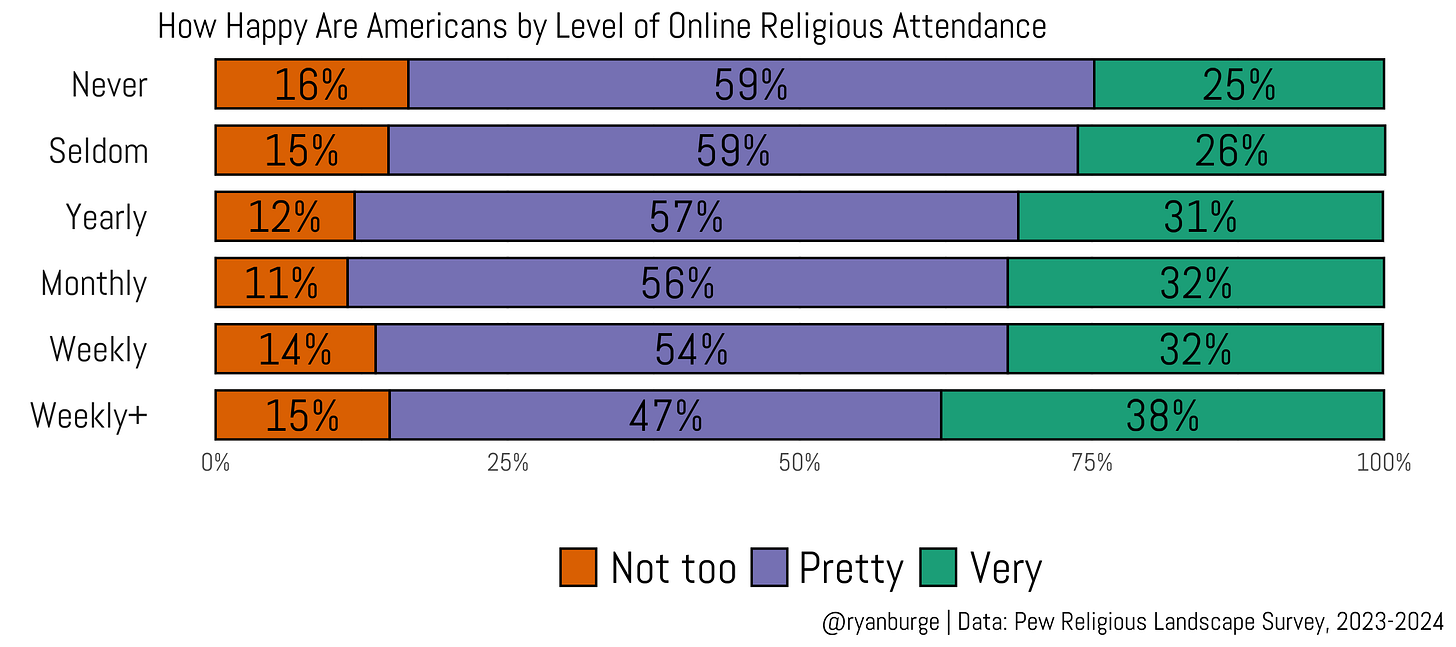
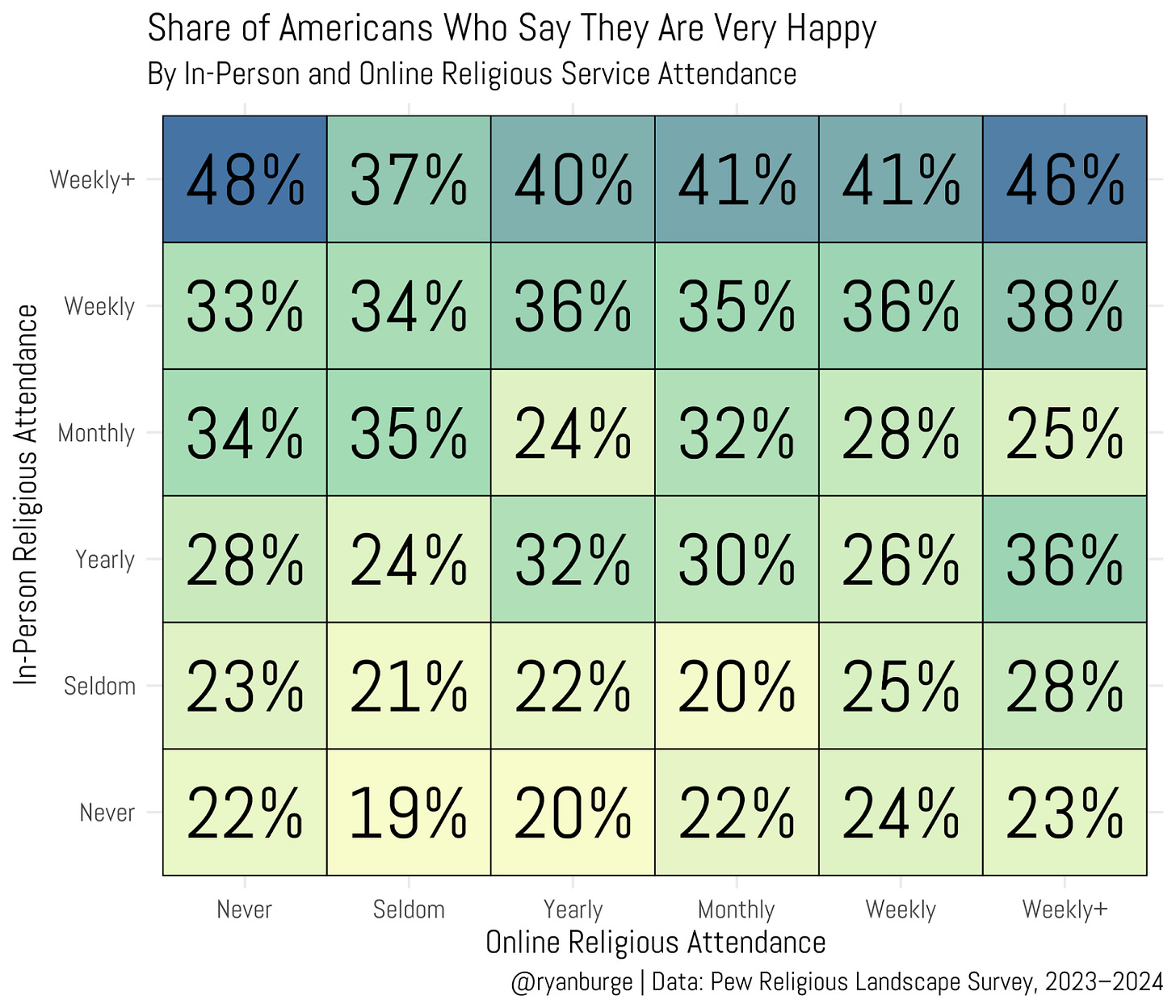
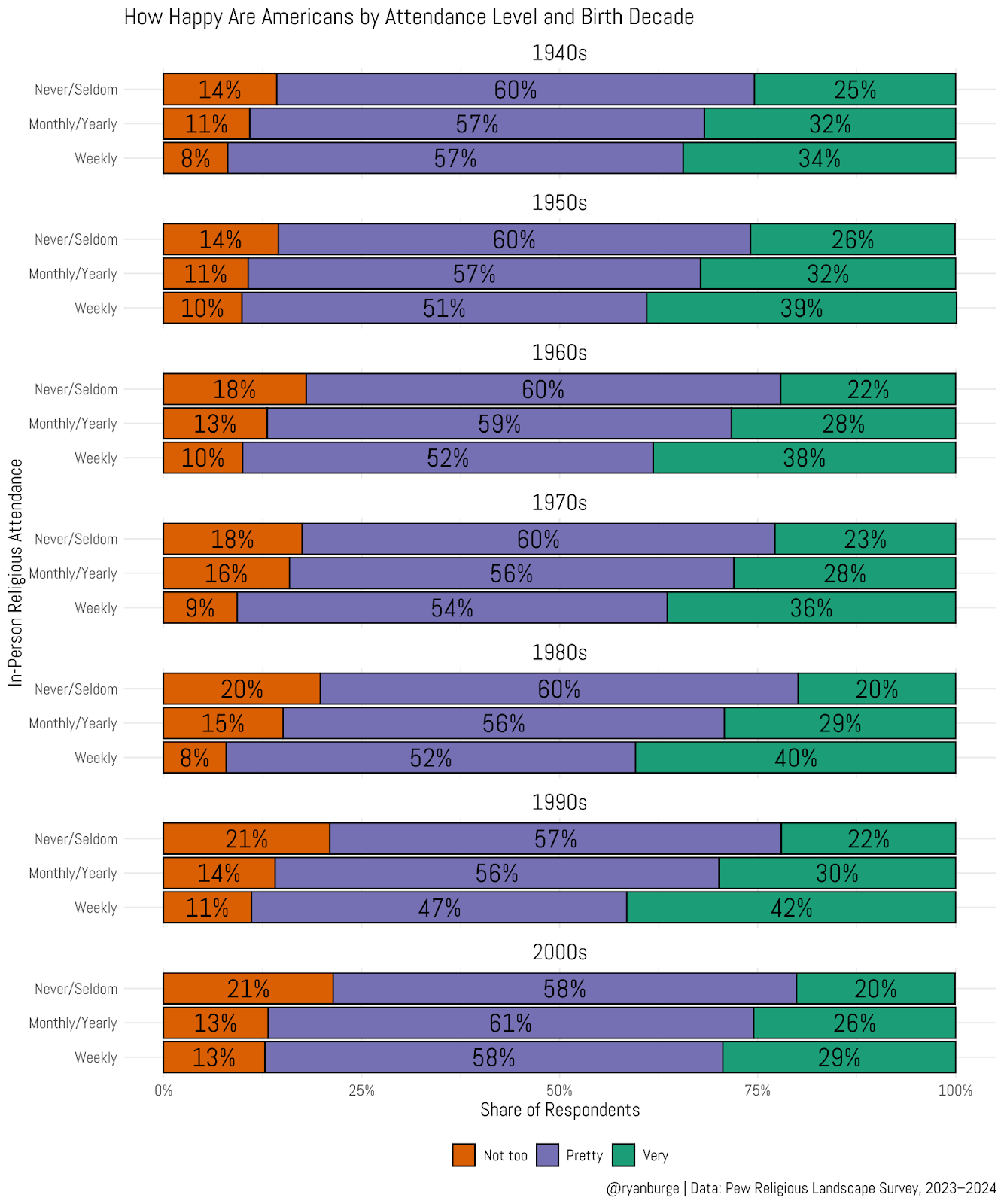
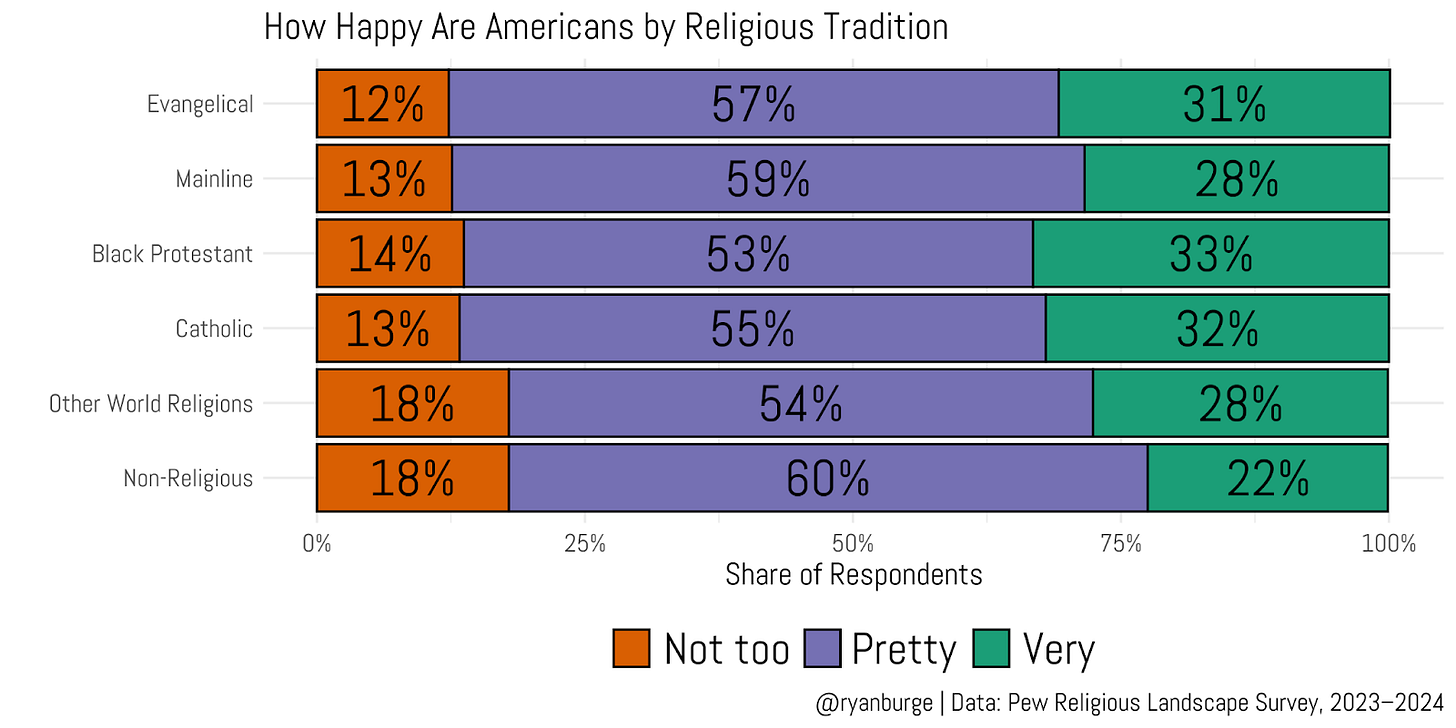
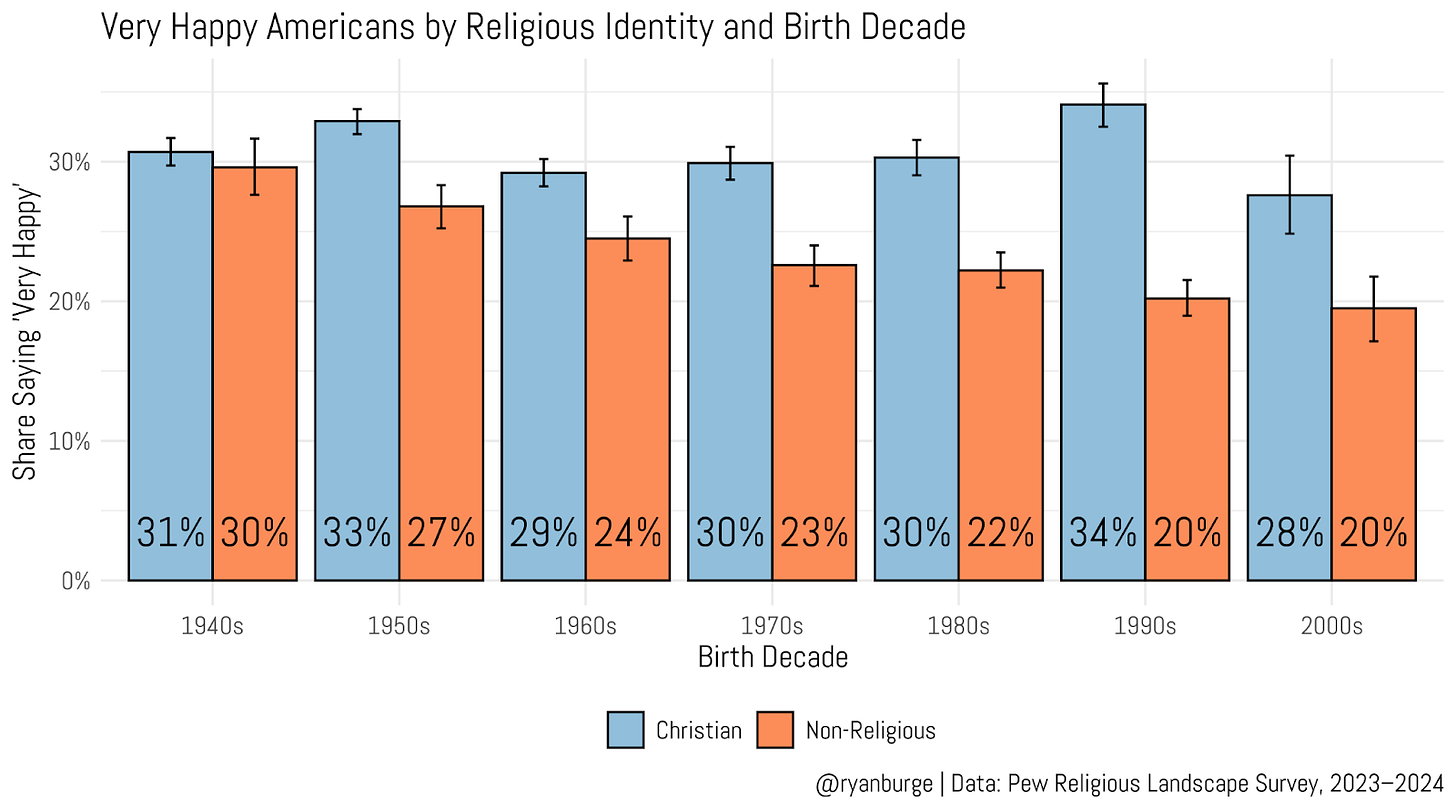

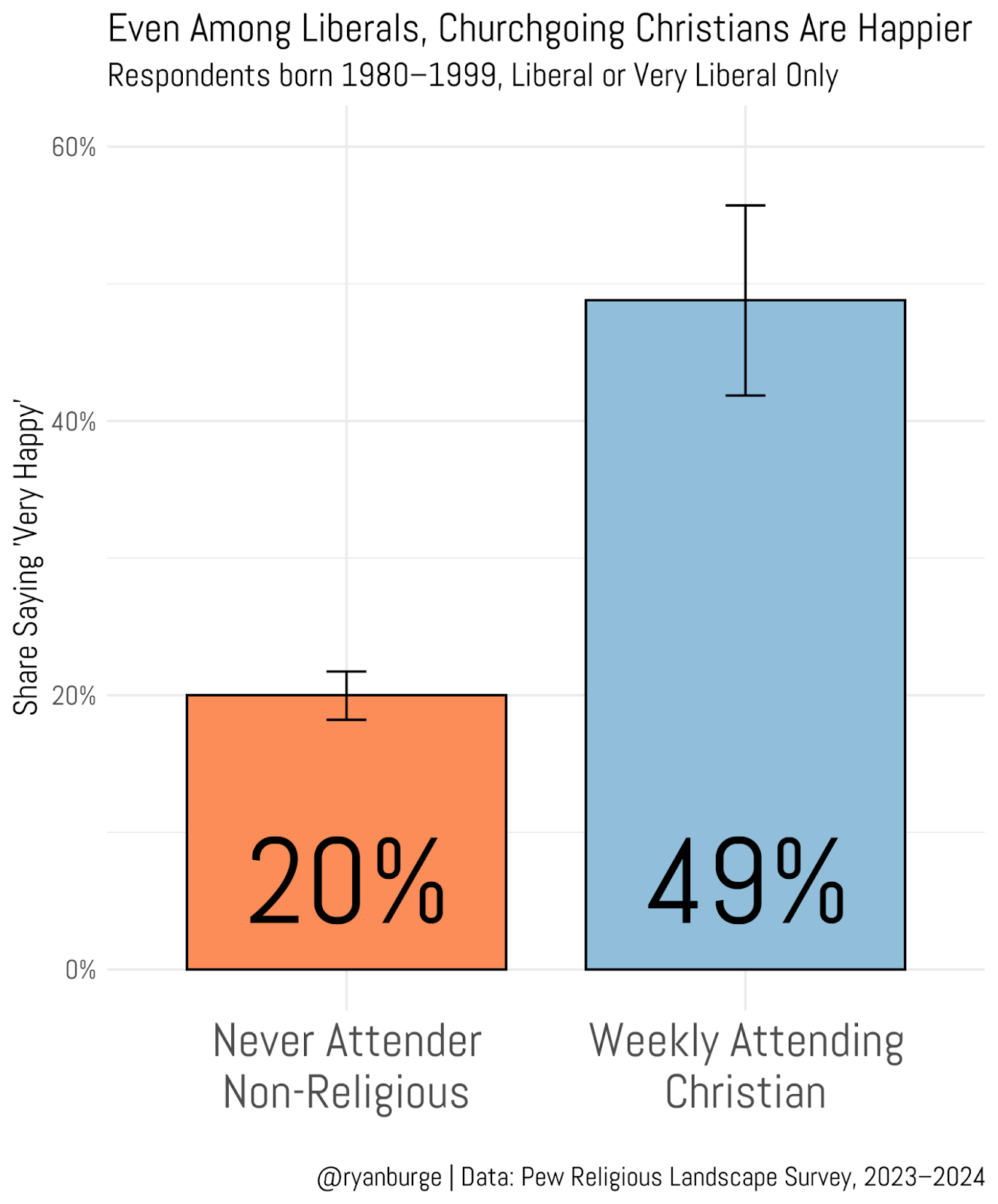

Here is another true thing: you do excellent work here as usual!
Looking forward to these happiness indicators controlled by your 4 types of Nones!